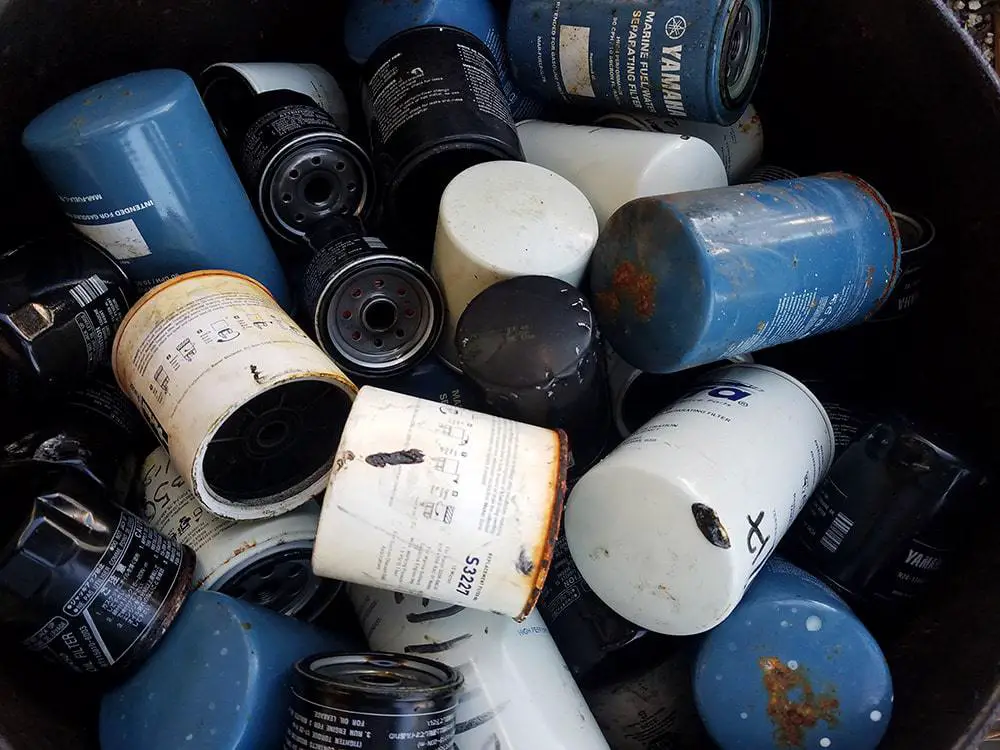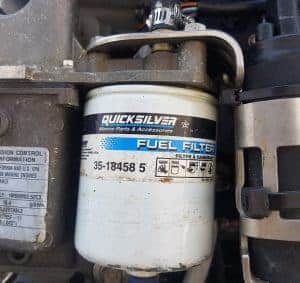You could spend hours and hours reading forums or watching YouTube videos of people debating whether or not you should pre-fill fuel filters and oil filters.
Seems to me that the oil filter debate is usually between diesel guys. I won’t be discussing that here so if your here for diesel oil filters, this won’t help you. This is about:
Should You Pre Fill A Boat Fuel Filter or Water Separator? Yes, pre-filling a boat’s fuel filter or water separator is a great habit. You won’t cause any harm to the engine and it will make your engines fuel lift pumps job much easier. This eliminates the introduction of a large amount of air into the fuel system.
Here is a list of the most common pros and cons to this debate. Along with the biggest reasoning behind both sides of the story.
How The Fuel System Operates
Understanding just a little bit about the fuel system will help decide whether or not it is a good thing or a bad thing to pre-fill the fuel filters.
By no means is this going to be a massive comprehensive or exhaustive description.
This will just help on the understanding of what is going on.
So, all engines, regardless of inboard or outboard, gas or diesel; have fuel pumps that suck fuel from the fuel tank.
Each manufacturer has their own specifications for the vacuum of each pump and what they can pull.
One thing that all engine manufacturers agree on, regardless of gas or diesel; is that introducing air into the system and running dry air through an injector, is very hard on the injector and can cause major damage to the injector.
Now, for the debate on pre-filling. Some say you should, some say you shouldn’t.
When you are changing the fuel filters on your boat (including anything with a fuel water separator); if you put the dry filter onto the bracket, you have just introduced a massive amount of air into the closed fuel system.
Closed meaning that there are no leaks from the pickup tube in the fuel tank, to the lift pump on the engine that is trying to suck the fuel out of the tank.
There is also the consideration of the distance from the tank to the pump.
The amount of air that is in the fuel filter over a short distance is not as hard on the pump as the longer distance is. No matter the distance though, it is still making the fuel pump work extra hard.
Why We Pre Fill Fuel Filters
This is the main reason why I pre-fill all of my fuel water separators. This eliminates that issue of having the air pocket in the fuel system.
With a full water separator, the issue of having all that air in it goes away. We are now talking about having a small amount of air which will work its way through the system; without air locking the fuel pumps.
Air locking the fuel pumps can turn into a huge nightmare. Yes, you can damage the injectors and cause serious problems.
Remember we are talking about water separators and boat fuel filters. Not the engine fuel filters. We’ll talk about that next.
I’m sure that the whole goal for most of you is to get the job done right, quickly, minus any damage to the engine. Which is why prefilling the fuel filters is such a good habit to have.
What To Do if the Engine Won’t Start After Changing the Fuel Filter?
Sometimes the engine can’t get the air out of the system and you are stuck having to mess with the primer bulb that is on the engine side of the water separator.
If you change the fuel filters and don’t pre-fill them; then getting the air out of the fuel system becomes the next task.
This means you are manually removing the air from the fuel system. The process for this is pretty simple but can be a huge hassle depending on where the primer bulbs are in the boat.
How to Prime a Fuel System on a Boat:
- Make sure that the primer bulb is on the engine side of the water separator bracket.
- Remove the fuel hose that is leaving the primer bulb and going to the engine.
- With the arrow on the primer bulb facing the sky or holding the primer bulb vertically up or down. (This is extremely important, DON’T hold the primer bulb horizontally.)
- Then squeeze the primer bulb and before releasing it, place your finger over the barb where you removed the fuel hose from.
- Then let go of the bulb.
- After the bulb expands, remove your finger and quickly squeeze the primer bulb.
- Then with the bulb squeezed, quickly place your finger back on the barb and release the bulb.
- Repeat this action until you have manually primed the air out of the fuel system and have fuel inside of the primer bulb.
- Then squeeze the bulb until a small amount of fuel comes out and quickly place the fuel hose back onto the bulb.
- Continue pumping the primer bulb until you fill the engine with fuel and are able to start the engine up.
- Don’t forget to tighten the hose clamp back up!
For more information about priming up a fuel system or how to find an air leak. Check out an article we wrote on the steps you need to take to fix it!
What About Engine Fuel Filters?
Engine fuel filters are a different story. In my opinion, we are talking about a small amount of air here.
Me personally, I don’t pre-fill the engine fuel filters. Unless it is a canister style or water separator style filter.
It is important to know that I mainly deal with outboard engines. So the fuel filters that they have are mainly inline fuel filters with quick disconnect fittings.
This allows the filter to quickly snap in place, into the fuel lines or a small fuel filter element that sits in a little cup that holds a small amount of fuel in it.
I’m sure that you could pre-fill this if you wanted to but I don’t think that it would be doing all that much for you.
Again, I personally don’t pre-fill any of the engine fuel filters with the exception of the canister style or water separator style filters and we never have any trouble with air locking the fuel system or running the fuel pumps dry.
What About Engine Oil Filters?
The same could be said about the oil filters.
Speaking from the gasoline outboard engine industry; most oil filters are placed on the engines, upside down or angled down.
So, pre-filling them is virtually impossible. Unless you enjoy making a large oil mess.
Another thing about pre-filling the oil filters; I don’t really see why it is necessary when we are talking about gasoline outboard engines.
Diesel may be different. There seems to be a massive controversy between mechanics on that issue.
Having limited diesel experience, I’ll be leaving that debate alone!
Back to the outboards though. The way that most outboards operate is that as the crankshaft spins, it drives the oil pump.
So as the engine is cranking over, it is pushing lightly pressured oil through all of the oil passages, including the oil filter.
It isn’t like it is just immediately blasting 80 PSI of oil into the filter, shredding the filter element; which is quickly filled as the engine starts and the oil system is back up and running properly without any damage.
So, as far as pre-filling the oil filter on an outboard, it’s a big no.
The Pros to Pre Filling
Back to the subject of the fuel water separators. There are many pros to pre-filling.
The biggest ones we have already touched on. Being that it eliminates the issue of filling all of the fuel systems with air.
Saving the fuel injects and lightening the priming load on the engines lift pumps.
Along with, saving yourself the time and aggravation of removing the primer bulb and going to town manually purging out all of the air from the fuel system.
So there are lots of reasons why we pre-fill all of our fuel water separators in the field.
The Cons to Pre Filling
As far as the cons go. I can really only think of one reason. That is checking for air leaks in the fuel system.
Theoretically speaking, if there are no leaks in the fuel lines and you put the filters on dry. The fuel pump should be able to suck fuel from the tank and purge out the air itself.
Again, we are talking about stress and lots of work being put onto the fuel pumps. But technically it should be able to do this without having any kinds of issues.
So this is kind of a self-test for air leaks in the fuel system. Which, to be honest with you if there are any air leaks in the fuel system; you are going to know about it.
We are talking about running issues, running out of fuel and WOT problems.
All kinds of sporadic issues can arise from introducing air into the fuel system and atomizing the fuel before the engine properly does this with the injectors.
Tell Us What You Think
So, what is your opinion? Do you think it is better to pre-fill or not to pre-fill?
For all the diesel guys out there, what do you think? What’s your opinion? What’s best for Diesel?
Let us know in the comment section below!
Something else that you might find interesting is an article that we wrote on What Ethanol Fuel Does To Your Engine & How To Burn It Safely!
You might also like to know Why A Boat Fuel Tank Overflows When Filling and the steps to take in order to fix it from doing it!
Check Us Out!
If you’ve got any questions or comments, let us know by subscribing to our YouTube Channel!
And if you would like to support us to continue bringing you great content, please click the link below to Amazon where we get a commission from anything you are already going to buy!
Click Here To Amazon!
And you can also donate by clicking the donate button here or on the right hand of the screen!
It really helps us out and we thank you so much for your support!
Thanks for reading and we look forward to reading your responses and comments.
Then we hope you will come and check us out our Youtube Channel: Born Again Boating!
We create all kinds of how-to videos, DIY boating, and outboard service hints tips and tricks!
We hope you will get subscribed to the channel and then add our site to your favorites so we can become your go-to resource for all of your outboard and boating projects!




